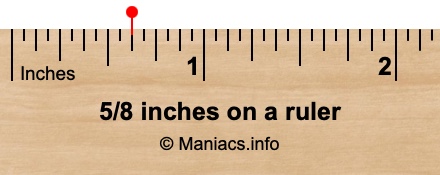Understanding Height Conversion: How Many Inches is 5’8″?
Height is a common measurement used in various contexts, from personal identification to fitness assessments and medical evaluations. One frequently asked question is how to convert feet and inches into just inches. For instance, how many inches are in 5 feet 8 inches? This article will explore this conversion in detail, providing a comprehensive understanding of height measurement, its significance, and practical applications.
The Basics of Height Measurement
Understanding the Units
Height is typically measured in feet and inches in the United States and some other countries. The imperial system uses feet (ft) and inches (in) as units of length.
- Feet: One foot is equal to 12 inches.
- Inches: An inch is a smaller unit of measurement, commonly used in everyday contexts.
Conversion Formula
To convert a height given in feet and inches to inches only, you can use the following formula:
Example Calculation for 5’8″
To find out how many inches are in 5 feet 8 inches, we apply the conversion formula:
- Convert Feet to Inches:
5 ft×12 in ft=60 in
- Add Remaining Inches:
60 in+8 in=68 in
Thus, 5 feet 8 inches is equal to 68 inches.
Importance of Height Measurement
Health and Fitness
Height is a critical measurement in health and fitness assessments. It is often used to calculate Body Mass Index (BMI), which helps determine if a person has a healthy weight relative to their height. Accurate height measurements are essential for:
- Medical Evaluations: Healthcare professionals use height to assess growth and development in children and to monitor health in adults.
- Fitness Assessments: Personal trainers and fitness experts often use height to tailor exercise programs and nutritional plans.
Clothing and Apparel
Height measurements are also crucial in the clothing industry. Understanding height helps manufacturers create size charts that accommodate different body types. For example:
- Men’s and Women’s Clothing: Size labels often include height ranges to ensure a better fit.
- Footwear: Shoe sizes may also consider the height of the wearer, especially for athletic shoes.
Construction and Design
In architecture and construction, accurate height measurements are vital for designing buildings, furniture, and other structures. Knowing the average height of individuals helps in creating spaces that are comfortable and accessible.
Height Conversion Table
To facilitate understanding, here is a table that shows various heights in feet and inches converted to total inches:
| Feet & Inches | Total Inches |
|---|---|
| 5’0″ | 60″ |
| 5’1″ | 61″ |
| 5’2″ | 62″ |
| 5’3″ | 63″ |
| 5’4″ | 64″ |
| 5’5″ | 65″ |
| 5’6″ | 66″ |
| 5’7″ | 67″ |
| 5’8″ | 68″ |
| 5’9″ | 69″ |
| 5’10” | 70″ |
| 5’11” | 71″ |
| 6’0″ | 72″ |
Practical Applications of Height Measurement
Sports and Athletics
In sports, height can be a significant factor in performance. For example:
- Basketball: Taller players often have advantages in shooting and rebounding.
- Gymnastics: Height can influence balance and performance in routines.
Ergonomics
Understanding height is essential in ergonomics, which focuses on designing products and environments that fit the users. For example:
- Office Furniture: Chairs and desks are designed with height considerations to promote comfort and reduce strain.
- Vehicle Design: Car manufacturers consider average heights when designing seating and controls.
The Science Behind Height Measurement
Understanding Human Height
Human height is determined by a combination of genetic, nutritional, and environmental factors. Genetics plays a significant role in determining an individual’s potential height, while nutrition and health during childhood and adolescence can influence whether that potential is fully realized.
Growth Patterns
- Childhood Growth: Most children experience rapid growth during infancy and early childhood. The growth rate typically slows down after the age of 2 but accelerates again during puberty.
- Puberty: During puberty, individuals experience a growth spurt, which is often more pronounced in boys than in girls. This growth spurt contributes significantly to adult height.
- Adult Height: By the late teens to early twenties, most individuals reach their adult height. After this period, growth plates in the bones close, and further height increase is not possible.
Measuring Height Accurately
Accurate height measurement is crucial for various applications. Here are some methods used to measure height:
- Stadiometer: A stadiometer is a device specifically designed for measuring height. It consists of a vertical ruler and a horizontal headpiece that can be adjusted to rest on the top of the head.
- Wall Measurement: A common method involves having the individual stand against a wall with their heels together, back straight, and head level. A flat object (like a book) is placed on the head, and the height is marked on the wall.
- Tape Measure: A tape measure can also be used, though it may be less accurate than a stadiometer or wall measurement due to potential discrepancies in positioning.
Factors Influencing Height Measurement
Several factors can affect the accuracy of height measurement:
- Posture: Standing up straight is essential for accurate measurement. Slouching can lead to a shorter recorded height.
- Time of Day: Height can vary slightly throughout the day due to compression of the spine. Individuals are typically taller in the morning than in the evening.
- Footwear: Measurements should be taken without shoes to ensure accuracy.
Height in Different Cultures
Cultural Perceptions of Height
Height can have different cultural meanings and significance. In some cultures, taller individuals may be perceived as more attractive or authoritative, while in others, height may not carry the same weight in social interactions.
Conclusion
In summary, converting height from feet and inches to total inches is a straightforward process that is essential for various applications in health, fitness, fashion, construction, and more. For the specific case of 5 feet 8 inches, the conversion yields a total of 68 inches. Understanding these measurements can enhance accuracy in numerous fields, ensuring that products and services meet the needs of individuals effectively.
FAQ Section
Q1: How many inches are in 5 feet 8 inches?
A1: There are 68 inches in 5 feet 8 inches.
Q2: How do you convert feet and inches to inches?
A2: To convert feet and inches to inches, multiply the number of feet by 12 and then add the remaining inches.
Q3: Why is height measurement important?
A3: Height measurement is crucial for health assessments, clothing fitting, ergonomic design, and various sports applications.
Q4: What is the formula for converting feet to inches?
A4: The formula is: Total Inches = (Feet × 12) + Inches.
Q5: Can height affect athletic performance?
A5: Yes, height can influence performance in various sports, providing advantages in certain positions or activities.
Additional Resources
For more information on height conversions and related topics, you can refer to the Wikipedia page on height measurement here.



